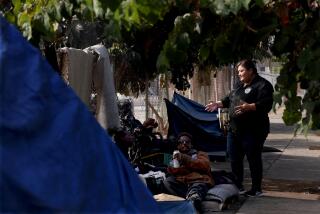Grouped Too Tightly? : Concentration of Homes for People With Special Needs at Issue in San Pedro
- Share via
Look at the map, they say, producing a grid of historic San Pedro studded with pushpins, some so tightly clustered that they nearly overlap. Each pin, they say, represents a “special-needs” housing facility--for the mentally ill, for the elderly, for homeless families, for recovering alcoholics or drug addicts or juvenile delinquents.
This, they explain, is why they organized, why they want a moratorium on such housing in their community, why they are lobbying to have local zoning controls strengthened--and why they want state and federal anti-discrimination protections narrowed.
“It’s really a question of balance,” said Janet Gunter, a leader of a 1 1/2-year-old group of merchants and homeowners in this port-side community.
The Community Advocates for Responsible Environmental Safety has been aggressively--and, some say, irresponsibly--campaigning to halt expansion of such facilities in their community. The group believes the facilities are bad for business in San Pedro’s struggling Old Downtown area and are spoiling some residential areas as well.
Its critics--including the president of the Harbor Area Collaborative, a coalition of local social service agencies, labor unions and religious leaders--accuse the group of using scare tactics to build its ranks. And they say it is turning the disadvantaged into scapegoats for the economic blows the community suffered with the closing of its shipyards and canneries and the loss of military installations.
“This is a small clique that is bashing the poor and those of us who serve them,” said Howard Uller, the collaborative’s president and head of the Toberman Settlement House. “They’ve tried to cast this as a case of business and homeowners versus the agencies and the poor; many of us are homeowners here too.”
The group’s leaders, however, believe their cause extends far beyond their corner of Los Angeles and resonates in more affluent suburbs.
They have sought out homeowners and local officials in California and beyond who want more say over who can be their neighbors. They have pushed for tighter controls from Sacramento and have endorsed San Diego Republican Rep. Brian Bilbray’s controversial attempt to narrow anti-discrimination protections in the Fair Housing Act, which would give cities more say in locating homes for recovering drug addicts, sex offenders or felons and would make it easier for homeowners to sue over such homes.
Closer to home, the group’s activities have spawned emotion-packed divisions in the insular community, where Councilman Rudy Svorinich Jr. convened a task force a year ago to assess the situation. City officials will try to resolve some of the issues Thursday, when the council’s Housing and Community Redevelopment Committee is scheduled to a hold a special meeting in the Peck Park Recreation Center.
Headed by Svorinich, the committee will consider several steps, including a controversial moratorium on additional special-needs housing in San Pedro.
“There is not going to be a moratorium on homelessness or poverty or hunger,” said Mary Gimenez, executive director of the Harbor Interfaith Shelter, which provides 17 homeless families--mostly single mothers with young children--shelter and other assistance for three months.
*
Harbor Interfaith’s plans for an additional facility, as well as other groups’ projects for housing for AIDS patients and for the disabled, could be affected by a moratorium.
“This is a very complex issue, and we are approaching it methodically,” said Svorinich, whom the group has accused of delaying the issue.
“We need to find a solution that will protect the integrity of our residential neighborhoods but also allow [housing] services to be available to those who need them,” Svorinich said. “We are probably not doing this as quickly as some folks would like, but it has to be done right and done right the first time.”
The Svorinich task force’s first job was to determine just what exists in the community.
“Special-needs housing” is a catchall term for myriad arrangements, many of which require licensing and oversight by one or more state or county agencies. Some receive public tax dollars to help care for their disabled or indigent clients or for youngsters in foster care.
Others, such as small “sober living” homes, provide a supportive environment for recovering drug addicts or alcoholics but offer no treatment programs or staffing, require no license or other permit.
There is no central registry for such a diverse lot, and, in California and many other states, homes of six or fewer unrelated adults must be treated under local zoning ordinances like any traditional family. A city cannot impose parking or other limits on a small group home that are not also imposed on homes that house a more traditional family.
San Pedro’s old harbor-side downtown area was once notorious for its sailors’ bars, which have gradually been leveled and replaced by government-assisted redevelopment projects including hotels and offices. The area has long had an abundance of large, empty old buildings with cheap rents. It is convenient to services and amenities, and compared with other parts of the city with similar building stock, it is safe and pleasant.
In the community of about 70,000 residents, the task force identified 52 special-needs facilities, plus 23 other homes whose uses it could not verify, housing about 1,600 people. (Community Advocates for Responsible Environmental Safety contends there are more, but it did not provide the task force evidence, citing the possibility that its members could be sued under federal anti-discrimination statutes.)
The verified special housing include two homeless shelters (one of which is open only three months of the year as emergency housing in inclement weather), three facilities for the mentally and physically disabled (including the Harbor View House for mental patients), four group homes for foster children and eight facilities for the elderly. The largest category is facilities for recovering drug and alcohol addicts--12 licensed agencies and 19 unlicensed “sober living” homes that do not render treatment or other services but provide a supportive living environment for people trying to stay free of drugs and alcohol.
The task force determined that there were no “halfway houses” for registered sex offenders or other state or federal prison parolees, nor any for runaway youths.
Half of the facilities lie within a 28-square-block area downtown, the task force found. But it was unable to compare San Pedro’s special-needs housing situation with that of other communities, and city housing officials said there is no standard for determining what is too little or too much; thus the question of whether San Pedro suffers from an “over-concentration” of such housing goes unanswered, except in the perceptions of those involved in the debate.
Nor did the Svorinich task force attempt to ascertain what proportion of special-needs housing residents came from within the community. CARES claims that the facilities attract “outsiders” who put an undue burden on San Pedro. The Harbor Area Collaborative alleges that most clients were already there and that the community is underserved.
The voting members of the 28-person task force included some CARES members and some special-needs housing providers as well as government, homeowner and business representatives. They split sharply over the moratorium and over a proposal to establish a “siting review board” for future homes.
The group reached consensus on other proposals, such as surveying merchants and residents to ascertain their views of special-needs housing, forming more neighborhood watch programs and seeking better monitoring and improved enforcement of health and safety codes. It also recommended changes in state and federal legislation that would extend distances between special-needs homes and require stricter monitoring, among other things.
Most attempts at giving local officials greater controls over residential zoning matters have run afoul of state and federal anti-discrimination laws regarding fair housing for the disabled. Crusades such as CARES’ worry advocates for the disadvantaged, from foster youths to the elderly, who fear loss of hard-won civil rights and an even tougher time finding enough places to meet growing needs.
“I would hate to see zoning restrictions; nobody wants any of [the facilities] in their neighborhoods,” said Charles W. Skoien Jr. of the Community Residential Care Assn. of California. His organization represents operators of facilities for the elderly, the chronically ill and the mentally ill and developmentally disabled.
*
With the closing of mental hospitals, the increases in the numbers of youths in foster care, and, especially, the dramatic increase of group homes for the elderly, Skoien says the need for these facilities will continue to grow. In California, for example, there are 500,000 people over age 85; that number is expected to grow to 1.1 million within 20 years.
Rather than zoning restrictions, Skoien proposes that facilities concentrate on being good neighbors and that government reimbursement to operators be increased to ensure adequate staffing and services, a view shared by many other special-needs housing advocates.
“There are very real problems that need to be addressed, but too many cities are just trying to push the poor out. It’s a simplistic approach,” said Maria Foscarinis of the National Law Center on Homeless & Poverty.
The center, which has issued several reports on how municipalities deal with the poor, is critical of actions in Hartford, Conn., that enacted strict zoning restrictions on social services agencies in its downtown, and in Long Beach, that adopted a one-year moratorium in March in its downtown area, which is undergoing extensive change and rezoning.
Long Beach’s moratorium applies to social service offices and such uses as recycling centers, tattoo parlors, gun shops, flea markets and residential care facilities housing seven or more.
CARES members said Hartford and Long Beach have the right approach and cite those cities as possible models for San Pedro.
The organization is preparing to incorporate as a nonprofit agency, which will enable it to raise money and adopt a more formal structure, CARES President Suzanne Strauss said.
Earlier this year the group collected more than 400 signatures from residents and business people endorsing a special-needs housing moratorium, the most controversial of several steps the council committee will consider Thursday. And last week Strauss and Gunter addressed the City Council in neighboring Rancho Palos Verdes, where some residents are expressing concerns about several small group homes for the elderly in their single-family neighborhoods.
At San Pedro’s Beacon House, a nationally recognized program for alcoholic men, Executive Director Mary Proper worries that licensed, highly regulated facilities such as hers would suffer under a moratorium and some other task force proposals. The small, unlicensed “sober living homes” that tangled with neighbors in San Pedro’s hillside neighborhoods would be largely untouched, she believes.
Everyone involved in the debate seems to agree that Beacon House is a model neighbor. It has improved the community by taking over unsavory hotels and apartment buildings, and its residents perform community service as part of their recovery, regularly scouring graffiti, cleaning alleys and volunteering in a thrift store that Beacon House operates jointly with the San Pedro YWCA.
“If everybody acted like Beacon House, we wouldn’t have a problem,” said Danee Petrich, a CARES member who says the tranquillity of her White Point neighborhood has been shattered by inconsiderate residents of a sober living house for men. They come and go at all hours of the day and night, get into shouting matches with children at the adjacent elementary school and crowd the narrow, hilly streets with their cars and boats; efforts to work out a solution with the owner or the residents have not worked, she said.
“People everywhere are very concerned about their families and their homes. That’s why CARES is growing,” Petrich said. “Its leaders are committed to seeing that the average person’s rights don’t get lost.”
More to Read
Sign up for Essential California
The most important California stories and recommendations in your inbox every morning.
You may occasionally receive promotional content from the Los Angeles Times.











